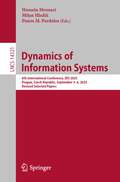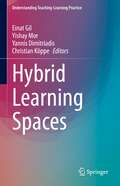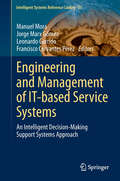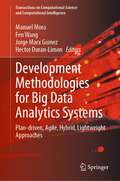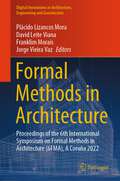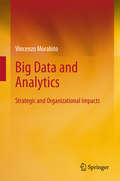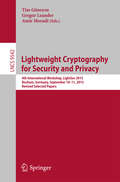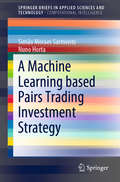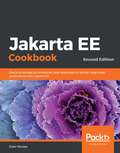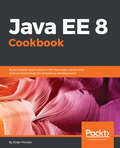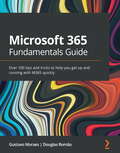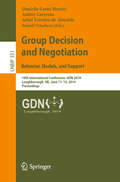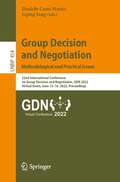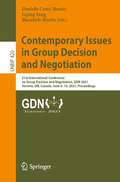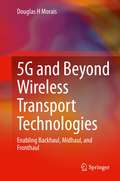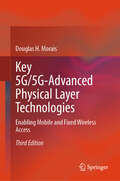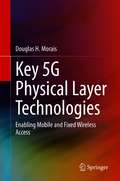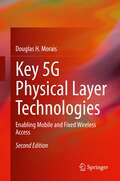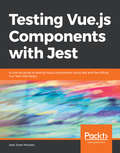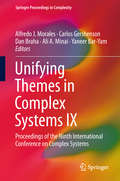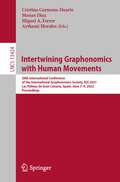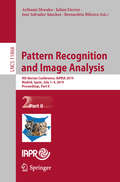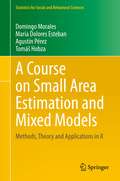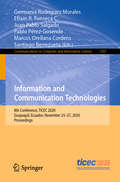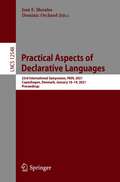- Table View
- List View
Dynamics of Information Systems: 6th International Conference, DIS 2023, Prague, Czech Republic, September 3–6, 2023, Revised Selected Papers (Lecture Notes in Computer Science #14321)
by Hossein Moosaei Milan Hladík Panos M. PardalosThis book constitutes the proceedings of the 6th International Conference on Dynamics of Information Systems, DIS 2023, which took place in Prague, Czech Republic, in September 2023. The 18 full papers included in the book were carefully reviewed and selected from 43 submissions. They deal with topics ranging from theoretical, algorithmic, and practical perspectives in information systems, to offering readers valuable information, theories and techniques.
Hybrid Learning Spaces (Understanding Teaching-Learning Practice)
by Yishay Mor Einat Gil Yannis Dimitriadis Christian KöppeAs we have come to accept the duality of physical and virtual learning spaces as a permanent feature of our educational landscape, we begin to question its validity. Is this really a dichotomy, or is it a continuum? Should this be the primary dimension around which we cluster educational experiences - how does it intersect and interact with other axes, such as formal-informal, vocational-recreational, open-closed, teacher-student? How do we adapt, as teachers, learners, designers, policy makers, to this changing landscape? How do we shape it to offer an optimal learning experience? Such questions led us to conduct a series of academic and professional events on the theme of Hybrid Learning Spaces (HLS) - spaces which challenge and defy the dichotomies above. This edited book collates some of the products of that endeavor, offering a multi-vocal, interdisciplinary approach to hybridity in education. It connects practical examples, design directives and theoretical analysis, combining perspectives from technology research and development, educational theory and practice, architecture and space and product design. This book addresses researchers, practitioners, innovators and policy makers in education, technology and design, offering broad perspectives and then distilling practical insights in the form of design principles and patterns, pedagogical models, and predictions of future trends.
Engineering and Management of IT-based Service Systems
by Manuel Mora Jorge Marx Gómez Leonardo Garrido Francisco Cervantes PérezIntelligent Decision-Making Support Systems (i-DMSS) are specialized IT-based systems that support some or several phases of the individual, team, organizational or inter-organizational decision making process by deploying some or several intelligent mechanisms. This book pursues the following academic aims: (i) generate a compendium of quality theoretical and applied contributions in Intelligent Decision-Making Support Systems (i-DMSS) for engineering and management IT-based service systems (ITSS); (ii) diffuse scarce knowledge about foundations, architectures and effective and efficient methods and strategies for successfully planning, designing, building, operating, and evaluating i-DMSS for ITSS, and (iii) create an awareness of, and a bridge between ITSS and i-DMSS academicians and practitioners in the current complex and dynamic engineering and management ITSS organizational. The book presents a collection of 11 chapters referring to relevant topics for both IT service systems and i-DMSS including: problems of selection of IT service providers, optimization of supply chain systems, IT governance decisions, clinical decision support, dynamic user-interface adaptation, re-engineering of processes, and generic decision problems. Advanced IT technologies used in some chapters are: fuzzy multi-criteria mechanisms, semantic processing, data mining processing, and rough sets. Other chapters report traditional DSS mechanisms but used or suggested to be used in innovative mode for IT service engineering and management tasks.
Development Methodologies for Big Data Analytics Systems: Plan-driven, Agile, Hybrid, Lightweight Approaches (Transactions on Computational Science and Computational Intelligence)
by Manuel Mora Fen Wang Jorge Marx Gomez Hector Duran-LimonThis book presents research in big data analytics (BDA) for business of all sizes. The authors analyze problems presented in the application of BDA in some businesses through the study of development methodologies based on the three approaches – 1) plan-driven, 2) agile and 3) hybrid lightweight. The authors first describe BDA systems and how they emerged with the convergence of Statistics, Computer Science, and Business Intelligent Analytics with the practical aim to provide concepts, models, methods and tools required for exploiting the wide variety, volume, and velocity of available business internal and external data - i.e. Big Data – and provide decision-making value to decision-makers. The book presents high-quality conceptual and empirical research-oriented chapters on plan-driven, agile, and hybrid lightweight development methodologies and relevant supporting topics for BDA systems suitable to be used for large-, medium-, and small-sized business organizations.
Formal Methods in Architecture: Proceedings of the 6th International Symposium on Formal Methods in Architecture (6FMA), A Coruña 2022 (Digital Innovations in Architecture, Engineering and Construction)
by Plácido Lizancos Mora David Leite Viana Franklim Morais Jorge Vieira VazThis book comprises the select proceedings of the 6th International Symposium on Formal Methods in Architecture (6FMA), A Coruña 2022. The contents focus on the use of methodologies, especially those that have witnessed recent developments stemming from mathematical and computer sciences and are developed in a collaborative way with architecture and related fields. This book constitutes a contribution to the debate and to the introduction of new methodologies and tools in the mentioned fields that derive from the application of formal methods in the creation of new explicit languages for problem-solving in architecture and urbanism. Some of the themes in the book are CAD and BIM, mixed realities, photogrammetry and 3D scan, architectural design automation, urban and building performance analysis, SCAVA-space configuration, accessibility and visibility analysis. This book proves a valuable resource for those in academia and industry.
Big Data and Analytics: Strategic and Organizational Impacts
by Vincenzo MorabitoThis book presents and discusses the main strategic and organizational challenges posed by Big Data and analytics in a manner relevant to both practitioners and scholars. The first part of the book analyzes strategic issues relating to the growing relevance of Big Data and analytics for competitive advantage, which is also attributable to empowerment of activities such as consumer profiling, market segmentation, and development of new products or services. Detailed consideration is also given to the strategic impact of Big Data and analytics on innovation in domains such as government and education and to Big Data-driven business models. The second part of the book addresses the impact of Big Data and analytics on management and organizations, focusing on challenges for governance, evaluation, and change management, while the concluding part reviews real examples of Big Data and analytics innovation at the global level. The text is supported by informative illustrations and case studies, so that practitioners can use the book as a toolbox to improve understanding and exploit business opportunities related to Big Data and analytics.
Lightweight Cryptography for Security and Privacy
by Amir Moradi Gregor Leander Tim GüneysuThisbook constitutes the refereed post-conference proceedings of the 4thInternational Workshop on Lightweight Cryptography for Security and Privacy,LightSec 2015, held in Bochum, Germany, in September 2015. The9 full papers presented were carefully reviewed and selected from 17submissions. The papers are organized in the following topical sections: cryptanalysis,lightweight constructions, implementation challenges.
A Machine Learning based Pairs Trading Investment Strategy (SpringerBriefs in Applied Sciences and Technology)
by Simão Moraes Sarmento Nuno HortaThis book investigates the application of promising machine learning techniques to address two problems: (i) how to find profitable pairs while constraining the search space and (ii) how to avoid long decline periods due to prolonged divergent pairs. It also proposes the integration of an unsupervised learning algorithm, OPTICS, to handle problem (i), and demonstrates that the suggested technique can outperform the common pairs search methods, achieving an average portfolio Sharpe ratio of 3.79, in comparison to 3.58 and 2.59 obtained using standard approaches. For problem (ii), the authors introduce a forecasting-based trading model capable of reducing the periods of portfolio decline by 75%. However, this comes at the expense of decreasing overall profitability. The authors also test the proposed strategy using an ARMA model, an LSTM and an LSTM encoder-decoder.
Jakarta EE Cookbook: Practical recipes for enterprise Java developers to deliver large scale applications with Jakarta EE, 2nd Edition
by Elder MoraesAn enterprise Java developer's guide to learning JAX-RS, context and dependency injection, JavaServer Faces (JSF), and microservices with Eclipse MicroProfile using the latest features of Jakarta EE Key Features Explore Jakarta EE's latest features and API specifications and discover their benefits Build and deploy microservices using Jakarta EE 8 and Eclipse MicroProfile Build robust RESTful web services for various enterprise scenarios using the JAX-RS, JSON-P, and JSON-B APIs Book Description Jakarta EE is widely used around the world for developing enterprise applications for a variety of domains. With this book, Java professionals will be able to enhance their skills to deliver powerful enterprise solutions using practical recipes. This second edition of the Jakarta EE Cookbook takes you through the improvements introduced in its latest version and helps you get hands-on with its significant APIs and features used for server-side development. You'll use Jakarta EE for creating RESTful web services and web applications with the JAX-RS, JSON-P, and JSON-B APIs and learn how you can improve the security of your enterprise solutions. Not only will you learn how to use the most important servers on the market, but you'll also learn to make the best of what they have to offer for your project. From an architectural point of view, this Jakarta book covers microservices, cloud computing, and containers. It allows you to explore all the tools for building reactive applications using Jakarta EE and core Java features such as lambdas. Finally, you'll discover how professionals can improve their projects by engaging with and contributing to the community. By the end of this book, you'll have become proficient in developing and deploying enterprise applications using Jakarta EE. What you will learn Work with Jakarta EE's most commonly used APIs and features for server-side development Enable fast and secure communication in web applications with the help of HTTP2 Build enterprise applications with reusable components Break down monoliths into microservices using Jakarta EE and Eclipse MicroProfile Improve your enterprise applications with multithreading and concurrency Run applications in the cloud with the help of containers Get to grips with continuous delivery and deployment for shipping your applications effectively Who this book is for This book is for Java EE developers who want to build enterprise applications or update their legacy apps with Jakarta EE's latest features and specifications. Some experience of working with Java EE and knowledge of web and cloud computing will assist with understanding the concepts covered in this book.
Java EE 8 Cookbook: Build reliable applications with the most robust and mature technology for enterprise development
by Elder MoraesA practical guide for building effective enterprise solutions with Java EE 8Key FeaturesRecipes to get you up-and-running with Java EE 8 application development Learn how to apply the major Java EE 8 APIs and specificationsImplement microservices and Reactive programming with Java EE 8Book DescriptionJava EE is a collection of technologies and APIs to support Enterprise Application development. The choice of what to use and when can be dauntingly complex for any developer. This book will help you master this. Packed with easy to follow recipes, this is your guide to becoming productive with Java EE 8.You will begin by seeing the latest features of Java EE 8, including major Java EE 8 APIs and specifications such as JSF 2.3, and CDI 2.0, and what they mean for you.You will use the new features of Java EE 8 to implement web-based services for your client applications. You will then learn to process the Model and Streaming APIs using JSON-P and JSON-B and will learn to use the Java Lambdas support offered in JSON-P. There are more recipes to fine-tune your RESTful development, and you will learn about the Reactive enhancements offered by the JAX-RS 2.1 specification.Later on, you will learn about the role of multithreading in your enterprise applications and how to integrate them for transaction handling. This is followed by implementing microservices with Java EE and the advancements made by Java EE for cloud computing.The final set of recipes shows you how take advantage of the latest security features and authenticate your enterprise application.At the end of the book, the Appendix shows you how knowledge sharing can change your career and your life.What you will learnActionable information on the new features of Java EE 8Using the most important APIs with real and working codeBuilding server side applications, web services, and web applicationsDeploying and managing your application using the most important Java EE serversBuilding and deploying microservices using Java EE 8Building Reactive application by joining Java EE APIs and core Java featuresMoving your application to the cloud using containersPractical ways to improve your projects and career through community involvementWho this book is forThis book is for developers who want to become proficient with Java EE 8 for their enterprise application development. Basic knowledge of Java is assumed
Microsoft 365 Fundamentals Guide: Over 100 tips and tricks to help you get up and running with M365 quickly
by Gustavo Moraes Douglas RomaoBecome a Microsoft 365 superuser and overcome challenges using the wide range of features offered by Microsoft 365 apps including SharePoint, Teams, Power Automate, Planner, and To-DoKey FeaturesEnhance your productivity with this consolidated guide to using all the tools available in Microsoft 365Improve your collaboration and maximize efficiency using various M365 featuresIntegrate project, task, and people management within one ecosystemBook DescriptionWith its extensive set of tools and features for improving productivity and collaboration, Microsoft 365 is being widely adopted by organizations worldwide. This book will help not only developers but also business people and those working with information to discover tips and tricks for making the most of the apps in the Microsoft 365 suite.The Microsoft 365 Fundamentals Guide is a compendium of best practices and tips to leverage M365 apps for effective collaboration and productivity. You'll find all that you need to work efficiently with the apps in the Microsoft 365 family in this complete, quick-start guide that takes you through the Microsoft 365 apps that you can use for your everyday activities. You'll learn how to boost your personal productivity with Microsoft Delve, MyAnalytics, Outlook, and OneNote. To enhance your communication and collaboration with teams, this book shows you how to make the best use of Microsoft OneDrive, Whiteboard, SharePoint, and Microsoft Teams. You'll also be able to be on top of your tasks and your team's activities, automating routines, forms, and apps with Microsoft Planner, To-Do, Power Automate, Power Apps, and Microsoft Forms.By the end of this book, you'll have understood the purpose of each Microsoft 365 app, when and how to use it, and learned tips and tricks to achieve more with M365.What you will learnUnderstand your Microsoft 365 apps betterApply best practices to boost your personal productivityFind out how to improve communications and collaboration within your teamsDiscover how to manage tasks and automate processesGet to know the features of M365 and how to implement them in your daily activitiesBuild an integrated system for clear and effective communicationWho this book is forWhether you're new to Microsoft 365 or an existing user looking to explore its wide range of features, you'll find this book helpful. Get started using this introductory guide or use it as a handy reference to explore the features of Microsoft 365. All you need is a basic understanding of computers.
Group Decision and Negotiation: 19th International Conference, GDN 2019, Loughborough, UK, June 11–15, 2019, Proceedings (Lecture Notes in Business Information Processing #351)
by Danielle Costa Morais Ashley Carreras Adiel Teixeira de Almeida Rudolf VetscheraThis book constitutes the refereed proceedings of the 19th International Conference on Group Decision and Negotiation, GDN 2019, held in Loughborough, UK, in June 2019. The field of Group Decision and Negotiation focuses on decision processes with at least two participants and a common goal but conflicting individual goals. Research areas of Group Decision and Negotiation include electronic negotiations, experiments, the role of emotions in group decision and negotiations, preference elicitation and decision support for group decisions and negotiations, and conflict resolution principles. The 17 full papers presented in this volume were carefully reviewed and selected from 98 submissions. They were organized in topical sections named: preference modeling for group decision and negotiations; collaborative decision making processes; conflict resolution; behavioral OR, and negotiation support systems and studies.
Group Decision and Negotiation: 22nd International Conference on Group Decision and Negotiation, GDN 2022, Virtual Event, June 12–16, 2022, Proceedings (Lecture Notes in Business Information Processing #454)
by Danielle Costa Morais Liping FangThis book constitutes the refereed proceedings of the 22nd International Conference on Group Decision and Negotiation, GDN 2022, which was held virtually during June 12–16, 2022. The field of Group Decision and Negotiation focuses on decision processes with at least two participants and a common goal but conflicting individual goals. Research areas of Group Decision and Negotiation include electronic negotiations, experiments, the role of emotions in group decision and negotiations, preference elicitation and decision support for group decisions and negotiations, and conflict resolution principles. This year’s conference focusses on methodological and practical issues. The 9 full papers presented in this volume were carefully reviewed and selected from 68 submissions. They were organized in the following topical sections: Preference modeling for group decision and negotiation; conflict resolution; collaborative decision making processes.
Contemporary Issues in Group Decision and Negotiation: 21st International Conference on Group Decision and Negotiation, GDN 2021, Toronto, ON, Canada, June 6–10, 2021, Proceedings (Lecture Notes in Business Information Processing #420)
by Danielle Costa Morais Liping Fang Masahide HoritaThis book constitutes the refereed proceedings of the 21st International Conference on Group Decision and Negotiation, GDN 2021, which was planned to be held in Toronto, ON, Canada, during June 6–10, 2021. The conference was held virtually due to the COVID-19 pandemic.The field of Group Decision and Negotiation focuses on decision processes with at least two participants and a common goal but conflicting individual goals. Research areas of Group Decision and Negotiation include electronic negotiations, experiments, the role of emotions in group decision and negotiations, preference elicitation and decision support for group decisions and negotiations, and conflict resolution principles. The 12 full papers presented in this volume were carefully reviewed and selected from 74 submissions. They were organized in topical sections as follows: pandemic responses; preference modeling for group decision and negotiation; conflict resolution; and collaborative decision making processes.
5G and Beyond Wireless Transport Technologies: Enabling Backhaul, Midhaul, and Fronthaul
by Douglas H MoraisThis text covers the key technologies employed in wireless links that enable increased data rates and thus are likely to be employed in support of 5G wireless transport networks, i.e., backhaul, midhaul, and fronthaul networks. The author presents technologies at an introductory level but nonetheless at a level that imparts to the reader a sound understanding of the fundamentals. The book is intended for those practicing engineers and graduate and upper undergraduate students who have an interest in acquiring, where missing, the necessary technology background in order to comprehend the functioning and capability of 5G based wireless transport links. The author focuses on those technologies that are key to achieving the high data rates and high reliability required of this transport. The material is presented in a clear, concise, and mathematically light fashion.Covers key wireless transport (backhaul, midhaul, and fronthaul) technologies for 5G and beyond, presented in a clear tractable fashion;Outlines the basic wireless transport transmitter/receiver terminal architecture, provides specifications of some such terminals, and indicates the link performance afforded by such terminals;Provides sufficient mathematics to make it technically coherent, but not so much as to make it challenging for a reader with no or limited familiarity with these technologies.
Key 5G/5G-Advanced Physical Layer Technologies: Enabling Mobile and Fixed Wireless Access
by Douglas H. MoraisThis third edition of this text covers the key technologies associated with the physical transmission of data on 5G mobile systems. Following an updated overview of these technologies, the author provides a high-level description of 3GPP’s mobile communications standard (5G/5G-Advanced) and shows how the key technologies presented earlier facilitate the transmission of very high-speed user data and control data and can provide very low latency for use cases where this is important. In the final chapter, an updated overview and the physical layer aspects of 5G NR enabled Fixed Wireless Access (FWA) networks is presented. Material in the second edition addressed mainly the key physical layer technologies and features associated with 3GPP Release 15, the first release to support 5G, and Release 16. This edition adds descriptions of some of the technological advancements supported in Releases 17 and 18, the latter being designated by 3GPP as 5G-Advanced. In addition to numerous enhancements of existing features, these releases include new features such as support for 1024-QAM in the downlink in the FR1 band, Reduced Capability (RedCAP) devices, Network Controlled repeaters, operation in the 6 GHz band and above 52.6 GHz, support for broadcast/multicast services, and Non-terrestrial Networks (NTNs). Additionally, a look ahead at some of the planned features and enhancements of Release 19 is provided. This textbook is intended for graduate and upper undergraduate engineering students and practicing engineers and technicians who have an interest in 3GPP’s 5G enabled mobile and or FWA networks and want to acquire, where missing, the necessary technology background in order to understand 3GPP’s physical layer specifications and operation. Provided are working problems and helpful examples throughout the text.
Key 5G Physical Layer Technologies: Enabling Mobile and Fixed Wireless Access
by Douglas H. MoraisThis book covers the key technologies associated with the physical transmission of data on fifth generation (5G) mobile systems. Following an overview of these technologies, a high-level description of 3GPP’s mobile communications standard (5G NR) is given and it is shown how the key technologies presented earlier facilitate the transmission of control data and very high-speed user data. In the final chapter, an overview and the physical layer aspects of 5G NR enabled Fixed Wireless Access (FWA) networks is presented. This book is intended for those practicing engineers and graduate and upper undergraduate engineering students who have an interest in 3GPP’s 5G enabled mobile and or FWA networks and want to acquire, where missing, the necessary technology background in order to understand 3GPP’s physical layer specifications and operation.Provides a comprehensive covering of key 3GPP 5G NR physical layer technologies, presented in a clear, tractable fashion, with sufficient mathematics to make it technically coherent;Addresses all key 5G NR technologies, including digital modulation, LDPC and Polar coding, multicarrier based multiple access techniques, and multiple antenna techniques including MIMO and beamforming;Presents an overview of 5G NR Radio Access Network (RAN) architecture and a detailed understanding of how user and control data is transported in the physical layer by the application of the technologies presented;Provides an overview and addresses physical layer aspects of 5G NR enabled Fixed Wireless Access networks.
Key 5G Physical Layer Technologies: Enabling Mobile and Fixed Wireless Access
by Douglas H. Morais This updated book, reconfigured as a textbook, covers the key technologies associated with the physical transmission of data on 5G mobile systems. Following an updated overview of these technologies, the author provides a high-level description of 3GPP’s mobile communications standard (5G NR) and shows how the key technologies presented earlier facilitate the transmission of very high-speed user data and control data and can provide very low latency for use cases where this is important. In the final chapter, an overview and the physical layer aspects of 5G NR enabled Fixed Wireless Access (FWA) networks is presented. Material in the first edition addressed mainly the key physical layer technologies and features associated with 3GPP release 15, the first release to support 5G. This edition adds descriptions of some of the technological advancements supported in release 16, including integrated access and backhaul (IAB), sidelink communication, NR positioning, operation in unlicensed bands, and multiple transmission points transmission. This textbook is intended for graduate and upper undergraduate engineering students and practicing engineers who have an interest in 3GPP’s 5G enabled mobile and or FWA networks and want to acquire, where missing, the necessary technology background in order to understand 3GPP’s physical layer specifications and operation. The author provides working problems and helpful examples throughout the text.
Testing Vue.js Components with Jest: A concise guide to testing Vue.js components using Jest and the official Vue Test Utils library
by Alex Jover MoralesUnit test your Vue.js components with this fully-featured JavaScript testing framework Key Features Understand the various testing styles and their purpose Gain insight into how to test methods by avoiding dependencies Explore snapshot testing and its applications Book Description Unit testing in modern component-based JavaScript frameworks is not straightforward. You need a test suite that is reliable and runs quickly. Components are connected to one another, and the browser adds a layer of UI, which makes everything inter-dependent while we test components in isolation. Jest is a fully-featured JavaScript testing framework that will do all your work for you. This book shows you how to test Vue.js components easily and take advantage of the fully-featured Jest testing framework with the aid of practical examples. You'll learn the different testing styles and their structures. You'll also explore how your Vue.js components respond to various tests. You'll see how to apply techniques such as snapshot testing, shallow rendering, module dependency mocking, and module aliasing to make your tests smooth and clean. By the end of this book, you'll know all about testing your components by utilizing the features of Jest. What you will learn Set up a Vue-test project to get started with Jest Unit test your components using techniques such as shallow rendering Gain insights into how to test the reactive parts in the logic of the Vue.js components Explore how to test deeply rendered Vue.js components Perform easy and quick tests with module dependency mocking, module aliasing, and more Know-how and when to use snapshot testing Who this book is for If you are a programmer looking to make your development process smooth and bug-free, this is an ideal book for you. Prior knowledge and experience of JavaScript will help you quickly and easily grasp the concepts explained in this book.
Unifying Themes in Complex Systems IX: Proceedings of the Ninth International Conference on Complex Systems (Springer Proceedings in Complexity)
by Alfredo J. Morales Carlos Gershenson Dan Braha Ali A. Minai Yaneer Bar-YamUnifying Themes in Complex Systems is a well-established series of carefully edited conference proceedings that serve to document and archive the progress made regarding cross-fertilization in this field. The International Conference on Complex Systems (ICCS) creates a unique atmosphere for scientists from all fields, engineers, physicians, executives, and a host of other professionals, allowing them to explore common themes and applications of complex systems science. With this new volume, Unifying Themes in Complex Systems continues to establish common ground between the wide-ranging domains of complex systems science.
Intertwining Graphonomics with Human Movements: 20th International Conference of the International Graphonomics Society, IGS 2021, Las Palmas de Gran Canaria, Spain, June 7-9, 2022, Proceedings (Lecture Notes in Computer Science #13424)
by Aythami Morales Cristina Carmona-Duarte Moises Diaz Miguel A. FerrerThis book constitutes the proceedings of the 20th International Conference of the International Graphonomics Society, IGS 2021/2022. Originally planned to be celebrated in September 2021, due to the COVID-19 pandemic it was held in June 2022.The 36 full and 3 short papers presented at the conference were carefully reviewed and selected from 41 submissions and reviewed by a committee of 67 reviewers. Out of the 41 conferences, 26 papers were selected to be published in this proceedings. The program was comprised of 6 oral sessions on the following topics: historical documents, forensic handwriting examinations, handwriting learning and development, and motor control. One additional poster session included papers on all previous topics, and three special sessions included papers on neurodegenerative disorders.
Pattern Recognition and Image Analysis: 9th Iberian Conference, IbPRIA 2019, Madrid, Spain, July 1–4, 2019, Proceedings, Part II (Lecture Notes in Computer Science #11868)
by Aythami Morales Julian Fierrez José Salvador Sánchez Bernardete RibeiroThis 2-volume set constitutes the refereed proceedings of the 9th Iberian Conference on Pattern Recognition and Image Analysis, IbPRIA 2019, held in Madrid, Spain, in July 2019. The 99 papers in these volumes were carefully reviewed and selected from 137 submissions. They are organized in topical sections named: Part I: best ranked papers; machine learning; pattern recognition; image processing and representation. Part II: biometrics; handwriting and document analysis; other applications.
A Course on Small Area Estimation and Mixed Models: Methods, Theory and Applications in R (Statistics for Social and Behavioral Sciences)
by Domingo Morales María Dolores Esteban Agustín Pérez Tomáš HobzaThis advanced textbook explores small area estimation techniques, covers the underlying mathematical and statistical theory and offers hands-on support with their implementation. It presents the theory in a rigorous way and compares and contrasts various statistical methodologies, helping readers understand how to develop new methodologies for small area estimation. It also includes numerous sample applications of small area estimation techniques. The underlying R code is provided in the text and applied to four datasets that mimic data from labor markets and living conditions surveys, where the socioeconomic indicators include the small area estimation of total unemployment, unemployment rates, average annual household incomes and poverty indicators. Given its scope, the book will be useful for master and PhD students, and for official and other applied statisticians.
Information and Communication Technologies: 8th Conference, TICEC 2020, Guayaquil, Ecuador, November 25–27, 2020, Proceedings (Communications in Computer and Information Science #1307)
by Germania Rodriguez Morales Efraín R. Fonseca C. Juan Pablo Salgado Pablo Pérez-Gosende Marcos Orellana Cordero Santiago BerrezuetaThis book constitutes refereed proceedings of the 8th Conference on Information and Communication Technologies of Ecuador, TICEC 2020, held in November 2020. Due to the COVID-19 pandemic the conference was held online. The 36 full and 7 short papers were carefully reviewed and selected from 117 qualified submissions. The papers are organized according to the following topical sections: biomedical sensors and wearables systems; data science; ICT´s applications; industry 4.0; smart cities; software development; technology and environment.
Practical Aspects of Declarative Languages: 23rd International Symposium, PADL 2021, Copenhagen, Denmark, January 18-19, 2021, Proceedings (Lecture Notes in Computer Science #12548)
by José F. Morales Dominic OrchardThis book constitutes the refereed proceedings of the 23rd International Symposium on Practical Aspects of Declarative Languages, PADL 2021, held in Copenhagen, Denmark, in January 2021. The 10 full papers were carefully reviewed and selected from 21 submissions. The papers present original work emphasizing novel applications and implementation techniques for all forms of declarative concepts, including programming with sets, functions, logic, and constraints. The papers are organized in the following topical headings: Foundations and Programming Concepts; Applications of Declarative Languages, and Declarative Approaches to Testing and Debugging. Due to the Corona pandemic PADL 2021 was held as a virtual event.
